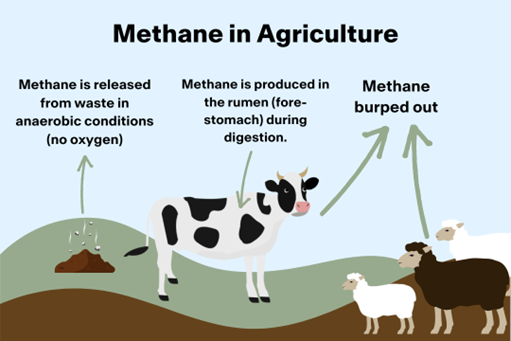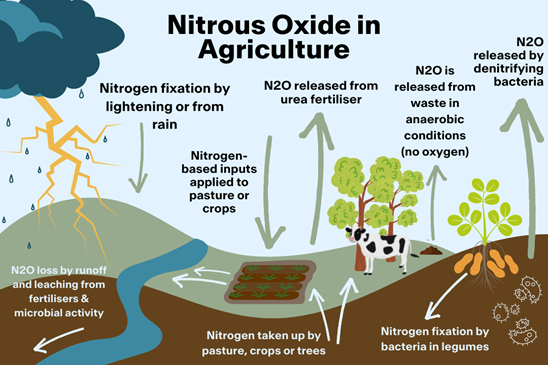We’re here to help you further understand the emissions your farming business may produce and how you can measure them.
The first step to any carbon sequestration or emission reduction journey is measuring the greenhouse gas emissions your farming business produces. Reducing emissions on your property has massive potential to improve the health of your soil, biodiversity, as well as your back pocket.
Whether you are wanting to become a verified carbon-neutral or carbon-positive business, or you’re looking to undertake a registered soil carbon project under the Australian Carbon Credit Unit (ACCU) Scheme, there are certain requirements to verify you are reducing your carbon emissions year-on-year.
First of all, what are greenhouse gas emissions?
To understand this, we need to go back a few centuries…
Carbon is cycled through the atmosphere at a natural rate. However, following the industrial revolution, the output of greenhouse gases has exponentially increased, beyond the point at which the natural cycling systems can keep up. Agriculture is just one of many sources of these emissions.
Farm-related emissions are typically released in the form of carbon dioxide (CO2), methane (CH4), and nitrous oxide (N2O). These three compounds have a big impact on our atmosphere’s heat-reflective layer, and the ability of the earth to maintain stable climatic conditions.
As the world is striving towards net zero, sectors that produce emissions are starting to find ways to change their processes to reduce their output of these gases. In the agriculture sector, it’s all about lowering the excess output of emissions through the precise application of fertilisers, herbicides, or other inputs, undertaking more fuel-efficient land management, along with added carbon sequestration projects, such as carbon farming.
So, what are the typical sources of emissions?
The three key compounds (CO2, CH4 and N2O) are cycled in and out of farming systems constantly. Check out the next three diagrams to understand what operations on your property may be contributing to the input and output of these gases.
 Figure 1. The sources and stores of carbon dioxide (CO2) in an agricultural system
Figure 1. The sources and stores of carbon dioxide (CO2) in an agricultural system

Figure 2. The sources of methane (CH4) in an agricultural system

Figure 3. The sources of nitrous oxide (N2O) and stores of nitrogen (N) in an agricultural system.
These emissions are categorised under three scopes:
- Scope 1: all emissions on-farm from agricultural activity.
- Scope 2: emissions from the production of purchased electricity.
- Scope 3: All emissions associated with producing inputs such as fertiliser, herbicides, veterinary services, etc.
When undertaking a carbon baseline, you will more often than not, focus on Scope 1 emissions. By calculating the outgoing and ingoing carbon, we can understand the whole farm’s baseline carbon account, and then work to inset these emissions through carbon farming projects.
Why should you baseline your carbon emissions?
With a growing demand for low-carbon, carbon-neutral or net-zero sourced food, your yields can gain a premium, if verified as one of the above. From low-carbon cotton to carbon-neutral crops, the market is growing globally.
What is a baseline carbon account?
The data you will need to begin includes:
- Stock numbers on hand (numbers x days on the farm per year)
- Liveweight at slaughter or disposal x age
- Weight of each class of animal
- Amount of wool produced per animal per year
- Yield of each crop with area and harvested weight
- Amount of fertiliser and herbicide applied per crop and pasture
- Purchased livestock and purchased animal feed
- Diesel use per enterprise
- Electricity and other energy sources
- Repairs, maintenance costs
- Purchased services and travel
These inputs account for an estimation of enteric methane, nitrous oxide and methane from manure, and both direct and indirect nitrous oxide emissions from cropping.
How do you calculate your emissions yourself?
Two key do-it-yourself calculators have been recommended by DPIRD based on their accuracy. These are:
- the Greenhouse Accounting Framework (GAF) and;
- the Cool Farm Tool.
The Greenhouse Accounting Framework
The GAF spreadsheets are downloadable onto your computer and are based on different industry sectors (i.e. beef/sheep, dairy, cropping, horticulture, etc). The tool is maintained to align with the Australian National Greenhouse Gas Inventory method, to measure the scale and sources of greenhouse gas emissions from farms.
With all your data handy, DPIRD recommends 10-15 minutes to input data into the cropping spreadsheet, and 30-35 minutes for the livestock spreadsheets.
The Cool Farm Tool
The Cool Farm Tool platform was built using over 100 global datasets, to provide a highly accurate platform for calculating your emissions. Taking just 10-15 minutes, the platform then allows you to alter your intended management practices to determine the best way to reduce your emissions. Using the same tool, you can also explore biodiversity management and your water footprint.
Want some support in calculating your emissions? CFF can help walk you through the process and produce your first emissions account. Learn more about it here.
Getting ACCU Scheme ready!
When it comes time to register a soil carbon project, there are a few things required to get your data ready for submission to the ACCU Scheme. Your emissions baseline data will accompany your first offset report, which along with your baseline soil data will provide a benchmark for your project to seek to improve on.
The CFF team is here to help you out with your emissions baselining and more when it comes time to register your project!
Ready to find out more?
Explore our range of educational resources in our Carbon Farming Education Hub where we frequently publish educational articles, webinars, and guidebooks.
When you’re ready to explore the feasibility of undertaking a carbon project on your property, email us at [email protected] or give us a bell at (08) 6835 1140 to be connected with one of our project facilitators.


![AFN – Cert Accredited Expert [RGB] AFN - Cert Accredited Expert [RGB]](https://carbonfarming.org.au/wp-content/uploads/elementor/thumbs/AFN-Cert-Accredited-Expert-RGB-e1725255016744-qti2uogw4b9a3s6au2d1bbf4utb8ggjuwvkj4qpce8.png)